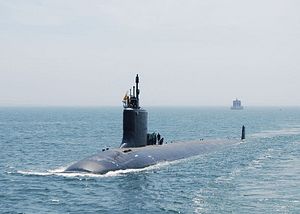It makes obvious sense that when studying any nation’s defensive doctrines or strategies you have to go to the source–to the native writings coming from leading scholars and researchers of that country. In the case of the People’s Republic of China, I would argue it is the only way to do it if you are looking to craft completely original research. Case in point: two prominent China scholars have uncovered a new twist in Beijing’s anti-access/area-denial strategy (A2/AD) that if fully deployed could have tremendous ramifications for U.S. defensive doctrine in the Asia-Pacific, the Air-Sea Battle concept, and beyond.
In last month’s issue of the United States Naval Institute’s Proceedings magazine, Lyle Goldstein and Shannon Knight explore recent Chinese writings that suggest Beijing “has deployed fixed ocean-floor acoustic arrays off its coasts, presumably with the intent to monitor foreign submarine activities in the near seas.” Citing works in Chinese journals such as Shandong Science, China Science Daily, Naval and Merchant Ships, two articles in Ship Electronic Engineering, and the widely respected Modern Ships seem to all but confirm China’s foray into this important area of military technology. As the authors note: “The sources presented here show beyond any reasonable doubt that China is hard at work deploying ocean-floor surveillance systems in its proximate waters.”
Goldstein and Knight should be praised for such a find–showing once again that mining native open-source texts can uncover a treasure trove of important scholarly and technical research. In these pages and in many others, it has been widely cited that China suffers from a lack of investment and know how in the important area of anti-submarine warfare and the technologies that power it. An investment in fixed acoustic arrays seems to be a big down payment on reversing such a glaring military weakness. The authors also point out such technology could help protect China’s budding efforts to deploy SSBNs.
I would highly encourage Flashpoints readers to analyze the full text as it is well researched and provides an important new piece of information regarding the ongoing development and evolution of Chinese A2/AD strategy and technology.
What matters, at least to me, is how this will impact American efforts to maintain access to strategically important areas along China’s coasts. If Beijing were to perfect such technology it could largely negate the military capabilities of America’s submarine forces, which in many respects are the foundation of the budding Air-Sea Battle operational concept. If China were able to field such a network–which according to the piece is setting up undersea-sensor test sites in the Yellow, East and South China Seas–then American subs could be pushed back beyond the range of such networks. This would impact the ability of American forces in a conflict to deliver kinetic strikes on the Chinese coast by way of Tomahawk Land Attack Missile (TLAMs). Considering the investment Washington is making in new versions of nuclear attack submarines, specifically a new version of the Virginia Class that includes a new payload module to carry more TLAMs, Washington would be wise to consider how to respond to Beijing’s latest move. Considering that in the next few years China could also field Russia’s SU-35 fighter aircraft, S-400 air-defense system, possible 5th generation fighters, and other advanced military platforms, American strategists seem to have their hands full. It appears that China’s armed forces will continue their push towards a much more modern and robust military—as well as an ever-advancing A2/AD strategy.

































